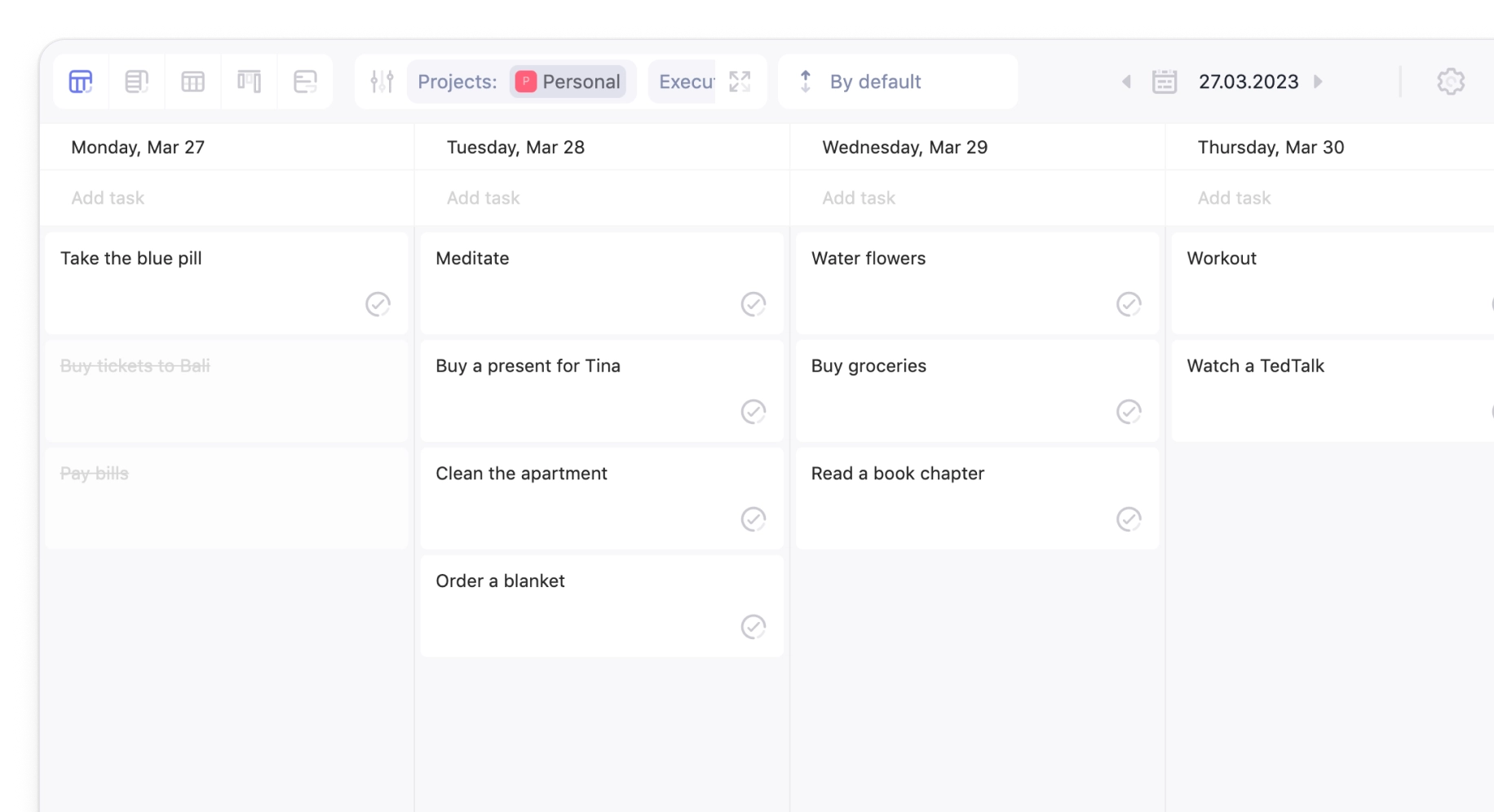Instead of paper notebooks we now have multifunctional electronic planners with calendars. There's no need to remember hundreds of urgent tasks — the service will remind you of them itself and even optimize your schedule. We've analyzed the top 10 planners with calendars, in our opinion, that will turn planning into a hobby.
WEEEK
A simple, pleasant tracker with a stylish design. And it's not just a planner but a whole system for team management. Tasks can be displayed as a list, board, or monthly and weekly calendar, store a multitude of documents in the Knowledge Base, and it includes CRM and Analytics.
Advantages
- Convenient Kanban-style calendar. Tasks from all projects are displayed at once, but they can be sorted by projects, statuses, and custom fields.
- With the weekly calendar, you can block time for tasks and work according to the GTD method—highlight priority tasks and "close" them one by one.
- Carry over unfinished tasks to another day and overdue marker.
- Flexible notification system—you can choose the type of notification and the place: email, Telegram, inside the service.
- Task time tracking.
- You can create tasks with a period—i.e., long tasks.
- Task time estimation. Generally suitable for a time-blocking system, although not quite the same.
- The calendar can be displayed by months: you can see the current month and the next one, with a visual highlight of the month change and weekends.
- The calendar can be shared, used jointly, and set flexible accesses.
- Priority labels, statuses, and custom fields of eight types.
- Synchronization with Google, Yandex, and Apple calendars.
- Free version allows import from Trello, Jira, Notion.

Disadvantages
- No option to set up the calendar for time-blocking and break down the week into hours.
- Many desktop features are missing in mobile apps. But this doesn't mean they won't appear in the future.
Pricing
Free with limitations — up to five people, a maximum of seven projects, and five boards. Then from $2.99 per month per person.
Platforms
- Windows
- Android
- iOS
- macOS
- Web
Asana
A popular task manager with an integrated calendar, understandable features, and a stylish minimalist design. In Asana, you can choose a convenient format: lists, boards, calendars.
Advantages
- The calendar displays as a week or month, with the ability to hide weekends.
- Tasks are added with one click, and in the extended window, there are additional attributes: description, date, subtasks.
- Integration with many services: Slack, Gmail, Microsoft Teams.
- Color coding to easily differentiate between personal and work meetings in the calendar.
- Labels and filters to prioritize tasks.
- You can create rules and automations.
- Has its own academy for mastering the service.

Disadvantages
- The monthly calendar does not fully display; scrolling is required.
- Numerous email notifications.
- Significant limitation of features on the free tier.
Pricing
- Personal — free tier, suitable for small groups up to 10 people. Starter — from $10.99 per month per user with annual payment.
Platforms
- Windows
- Android
- iOS
- macOS
- Web
Notion
Hardly anyone hasn't heard of Notion. It's one of the most popular services for to-do lists but is also used as a task manager, a collaboration tool, a document storage, and a database.
Advantages
- Numerous customization and organization options. Suitable for those who like to tweak settings and tailor the planner to their needs.
- Calendar viewable by month and week.
- Dozens of templates. You can create your own and share them with users.
- Multiple attributes on the task card: statuses, sync options, conference link, color design choice, cover for the task, and much more.
- Quick import from Asana, Evernote, Trello, Google services, Dropbox, and others. Synchronization with Google, Outlook, iCloud calendars, with Todoist, Google Tasks, Gmail.
- Integration with third-party products: from Github to X (formerly Twitter).
- You can share both a specific task and the entire calendar.
- Cool apps on all platforms.

Disadvantages
- Adding a calendar is not straightforward. To figure it out, you'll need to read the guide or look up tips on external resources.
- No quick task addition; after clicking on a date, it sends you to the extended task card.
- The vast amount of settings can be a downside for those who value simplicity and don't want to spend a lot of time on customization.
- Steep learning curve.
- No Russian language. This could be a problem for some.
- The mobile version is slow to load. The developers are trying to solve this problem, but so far, they are not very successful.
Pricing
- Free version with limitations. Beyond that, from $8 per month per user with annual payment.
Platforms
- Windows
- macOS
- Android
- iOS
- Web
ClickUp
ClickUp is a task management system that allows teams to organize and track projects from start to finish.
Advantages
- More than 15 customizable ways to view tasks.
- Integration with Google, Apple, and Outlook calendars.
- Calendar access settings.
- The calendar is displayed in four views: day, four days, week, month.
- When quickly adding a task, you can specify the end date, and it will stretch across the entire calendar.
- More than 1000 integrations with other work tools.
- Customizable to suit your needs. Many calendar view settings: you can display subtasks, hide weekends, choose a color for tasks.
- Magnificent design and animation.

Disadvantages
- The monthly calendar does not fully display on all screens. For example, on my 13-inch Macbook Air, I have to scroll down to view tasks.
- The extended task card has few attributes that can be added. Enough for personal use, but maybe insufficient for a team.
- Subscription is not cheap — from $7.
Platforms
- Windows
- Android
- iOS
- Linux
- Web
Pricing
- Free forever, but with limitations. There are four tiers, the cheapest is $7 per user. Free trial for 14 days.
Google Calendar
Almost all operating and search system manufacturers have developed their own planner integrated into the calendar. However, Google Calendar remains the most popular. It is loved for its convenience, accessibility, and simple interface.
Advantages
- Convenient, intuitive interface.
- Access to Google Calendar is available to most people.
- Google Keep and Google Tasks are integrated.
- Events from Gmail are imported automatically.
- Cross-platform compatibility.
- You can create multiple calendars and share them with other users.
- Integrates with other Google services.
- Calendar views: day, week, month, year, schedule, 4 days.
- Ideal for setting up time blocks.

Disadvantages
- You cannot create to-do lists without linking them to a specific date.
- Poor integration with other services. Even if integration is available, it might be super inconvenient.
- Very limited functionality. It seems that large organizations with complex projects will not find Google Calendar sufficient.
- Insufficient security and privacy controls. Users cannot encrypt data, set passwords, revoke access to calendars, or prevent copying, forwarding, or modifying events.
Platforms
- All browsers
- Android
- iOS
Pricing
- Free
Yandex Calendar
The Russian counterpart to Google Calendar from Yandex, which is part of its 360 ecosystem. There's no separate app; essentially, it's a cloud table with advanced features.
Advantages
- Numerous task settings. Beyond standard titles and descriptions, you can add a link to video meetings through Telebridge, divide into important and optional participants, mark their availability, and specify who can see, edit, or invite others to tasks, and set statuses. Notifications can be received not only by email but also by SMS and through CalDav.
- Flexible task field customization: unnecessary ones can be removed, necessary ones can be displayed.
- You can add external calendars or create your own.
- Day, week, or month calendar display. There's a color scheme setting for the calendar, with 10 colors available.
- Import of external calendars by link or from a file. Completely free.
- Synchronization with other calendars.

Disadvantages
- Unlike Google Calendar, it cannot import events from email to the calendar. Lacks push notifications. Does not work offline. In the mountains or on a plane, it turns into a pumpkin until you find the Internet.
- No separate app. The calendar is just part of the Yandex 360 ecosystem. Updates are very rare. It gives the impression that it was made and then forgotten.
- Lacks integration with other services.
- No search function—you have to search manually.
Platforms
- Web only
Pricing
- Free
Zoho Calendar
A free online calendar with a vast set of features and a sleek design from the creators of Zoho Writer, Zoho Mail, Zoho Docs, and many other services. You can create events and share them with friends, as well as check the availability of acquaintances and schedule meetings at a convenient time.
Advantages
- Multiple display types: you can view tasks for a day, week, workweek (customizable), month, two months, three months, year, and as an agenda.
- When inviting people, you can see their availability if they've made their calendar public. This is convenient—you always know if the person can join the event. Or you can send a request to join an event noted in someone else's calendar.
- Flexible notification settings: by email, push, or standard notifications. There's a timing setting for notifications—from five minutes to six days.
- Synchronization with Zoho Mail, Zoho Tasks, Microsoft Outlook, Google Calendar, OS X Calendar.
- You can set Zoho Calendar as private or public and share it with others. Moreover, Zoho Calendar supports the iCal format. This means you can share the .ICS file of the calendar with others. You can create an HTML link to the calendar and send it to someone. They can view the calendar as a web page without any special software.
- Great feature: automatically accept invitations to events if you have nothing else on that day. If there's already an event at that time in the calendar, the calendar automatically declines the new one.
- Mobile apps include a widget—you can check the calendar without opening it.

Disadvantages
- Synchronization issues can occur.
- Lacks integration with other services, such as Telegram.
- Missing synchronization with Gmail, which is the main email box for most people.
- If you encounter problems, reaching customer support may be difficult.
- You cannot set subtasks.
Platforms
- Web
- Android
- iOS
Pricing
- Free
❗There are also calendars from Mail.Ru, Microsoft, and Apple, but they do not significantly differ from Google, Yandex, or Zoho Calendars. Some may find one more convenient than the others.
YouGile
A project management and team communication system. The main difference from other services is a chat in each task, meaning the service combines a task tracker and a corporate messenger. Working in YouGile requires patience, as some functions operate "old school"—many clicks for a single action.
Advantages
- The calendar displays the week number. There's a chat where colleagues can discuss the event. You can set access to the calendar via a link. Subtasks in the event card.
Disadvantages
- You cannot customize the calendar display — only a weekly view is available. This is extremely inconvenient!
- The service lags even when creating tasks. Windows can take a long time to close. Non-intuitive design; you have to search even for the "Close" option. Renaming a task with one click isn't possible — you'll have to click on the three dots first, then select "rename," and only then proceed to editing. And so it is with almost all functions.
- It's impossible to make subtasks related in a way that one subtask cannot be completed until another is done.
- The paid tier doesn't offer new features but merely grants access to additional users. And the features are lacking.

Platforms
- Windows
- macOS
- Android
- iOS
- Linux
- Web
Pricing
-
Always free for up to 10 users in a team without limitations. Beyond that, from 333 ₽ per month —like a bowl of soup.
LeaderTask
A universal service for planning, creating, and tracking tasks, suitable for both personal and team use.
Advantages
- Quick synchronization with other devices.
- Issues related to tasks or notes can be discussed in the built-in chat.
- Tasks can be labeled with colors.
- Convenient note filtering.
- Tasks can have audio messages, notes, comments, photos, and documents attached.
- Unfinished tasks and assignments automatically carry over to the next day.
- Flexible settings that allow you to customize the service for yourself.
- Ability to track employee efficiency.

Disadvantages
- The design may not be appealing to everyone.
- Feature discrepancies across different platforms.
- Unable to view a list of tasks for the week or month—only available daily. You can switch between days using the navigator in the top left corner.
- Dragging in the calendar to select multiple days, as mentioned in the FAQ section, should display tasks tied to the days within the selected period. However, this did not work for me.
Platforms
- Web
- macOS
- iOS
- Android
Pricing
- There's a free tier with limitations. Beyond that, from 241 ₽ per month with annual payment.
Obsidian
A private and flexible application for tracking tasks and creating notes, which adapts to the user. The service supports working with a knowledge base in Markdown-text format.
Advantages
- A vast amount of plugins that allow you to download the appropriate calendar, and the calendar functions will depend on the plugin.
- Allows storing all notes locally.
- Features an offline mode, facilitating constant access to notes.
- Good service performance, works fast with minimal lag.
- Supports GitHub Markdown.
- Enables teamwork on shared files without compromising personal data.
- The appearance can be customized or chosen from a ready-made gallery of themes.

Disadvantages
- No web version.
- PDF export works unstably.
Platforms
- macOS
- iOS
- Android
- Linux
Pricing
- There's a free version forever with limitations. Paid version — $50 per year per user.
Focuster
Focuster not only helps to fix tasks but also to control their execution. For example, if you enter a task, the service will block it for a certain time and include it in the daily schedule.
Advantages
- Modern interface.
- Structurally, Focuster is divided into two or three parts (depending on which calendar you choose: for the day, 4 days, or the week).
- In the daily calendar, there are 3 blocks: on the left - folders with tasks, in the center - a list of tasks for the day where you add a task, and it automatically duplicates in the block on the right, where tasks for the day are already divided by hours.
- Simpler with the 4-day and weekly calendar, there are not so many elements - only the block with folders and the block with days of the week.
- Various calendar formats: daily, weekly, and 4-day schedules.
- Kanban boards and daily schedules - on one screen.
- Synchronization with Google Calendar.

Disadvantages
- Overloaded interface.
- Cannot add subtasks.
-
No version for Android, and the iOS version is underdeveloped.
- Difficult to use for team work - no onboarding, unclear how to delegate tasks, monitor employees' work, etc.
Pricing
- Two subscription options: Basic — 590 ₽ per person per month (but there are limitations - no Trello integration, time blocking, etc.) and Pro — 1100 ₽ per person per month without limitations. Upon registering in Focuster, a trial Pro period of 14 days is immediately activated to help you decide if the service suits you and if you need a Pro subscription.
Platforms
- Web
- Windows
- macOS
- iOS













